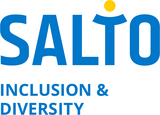Adapting Methods for people with a Disability
- Find this and a lot more in the SALTO Inclusion for All booklet: No Barriers, No Borders
The choice of a method depends on the aims or objectives we have in mind, which method or activity we'll do and how this will look. A method or activity only works if it is adapted to the target group (being aware of the different abilities), but also to what you as a youth worker feel comfortable with, to the resources you have available (money, time, space) and what the policy of your organisation is...
There are innumerable useful exercises, methods and activities in the SALTO Toolbox for Training and Youth Work at www.SALTO-YOUTH.net/Toolbox/. Here are some examples of adapting methods.
- Alphabetical chairs www.salto-youth.net/find-a-tool/98.html
This method is a funny way of getting to know each other's names and of breaking the ice. Everyone stands on a line of chairs and then has to sort themselves in alphabetical order according to their first name (or birthday or ...) without touching the floor.
If you have people with a disability in the group, you could instead of standing on chairs ask participants to hold onto a rope, and they need to order themselves without ever letting go completely of the rope (always one contact point)
- Perfume Groups www.salto-youth.net/find-a-tool/12.html
You can divide people into groups by spraying a perfume on their hand (while they have their eyes closed). Participants have to go and find the members of their subgroup who have the same perfume.
If you have participants who are allergic to perfume or who can't smell, you could alternatively divide people into groups giving each a different textures (wool, linen, plastic, paper, tin foil,...) or colour.
- Statement Game www.salto-youth.net/find-a-tool/280.html
The usual format of this discussion exercise is that people position themselves on different sides of the room (there is a sign 'I agree' and 'I don't agree' on the different sides) based on a statement.
If it is difficult for some people to move or for some people to see where everybody stands, you could alternatively ask some participants to make faces of live statues (with some participants) according to their reaction to the statement. The visually impaired persons could then feel the faces or live statues.
^^ top ^^
Working with specific types of disabilities
Follow the links to find different tips & tricks to adapt your programme to young people specific disabilities:
 SALTO Inclusion through Sports
SALTO Inclusion through Sports
 Active Methodology
Active Methodology
Downloads
The following downloads are available:
- No Barriers No Borders - international mixed-ability projects - 2008 update
How to set up international projects with young people with and without a disability. With lots of tips & tricks about partnerships, funding, working with disability,... Based on SALTO TC Enable 2003
